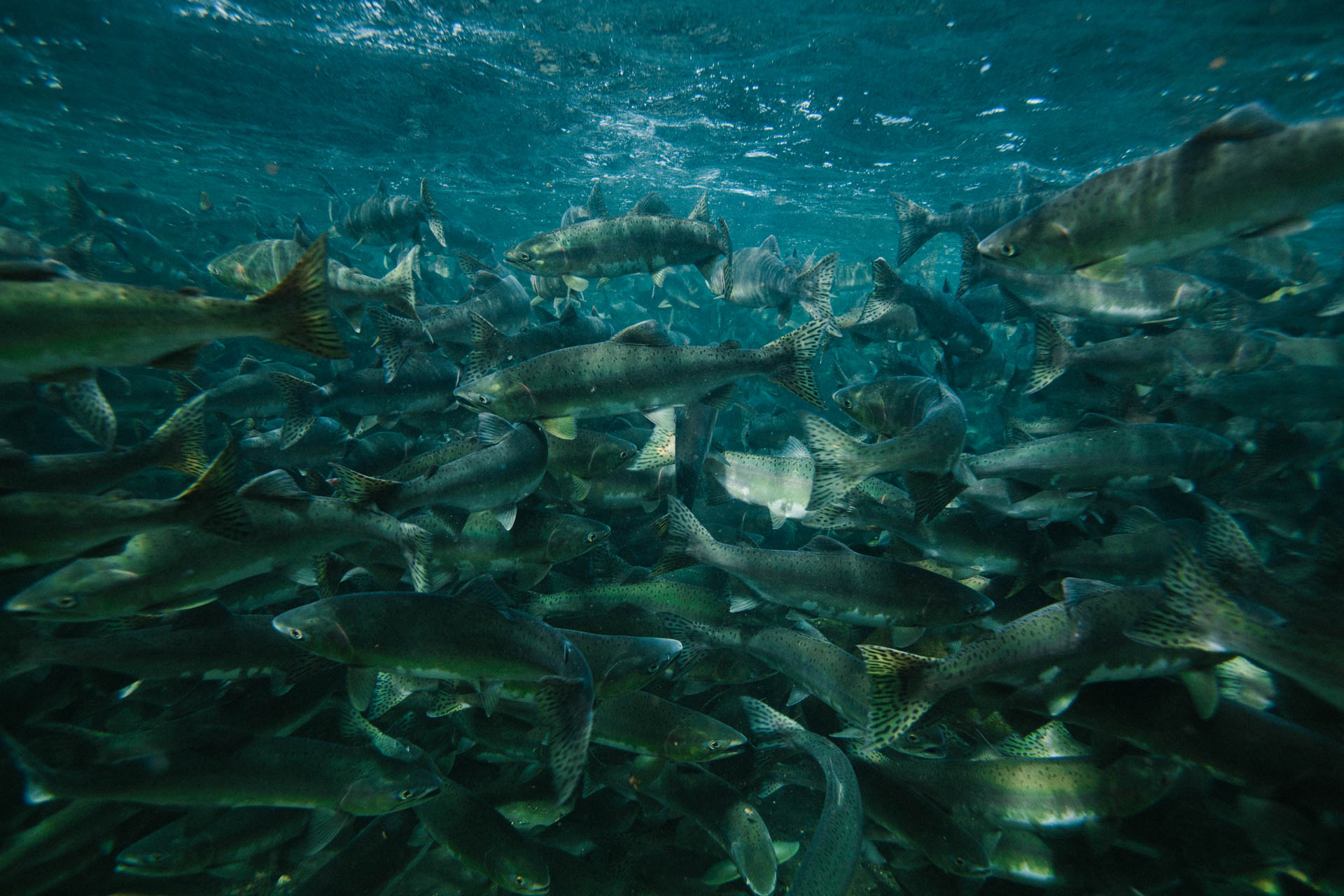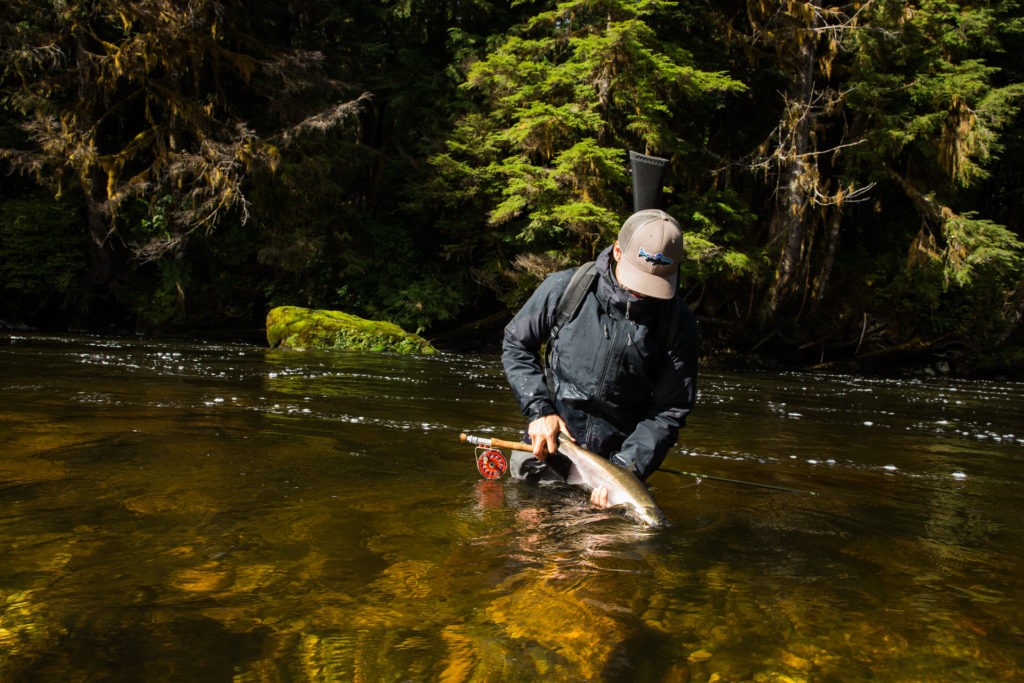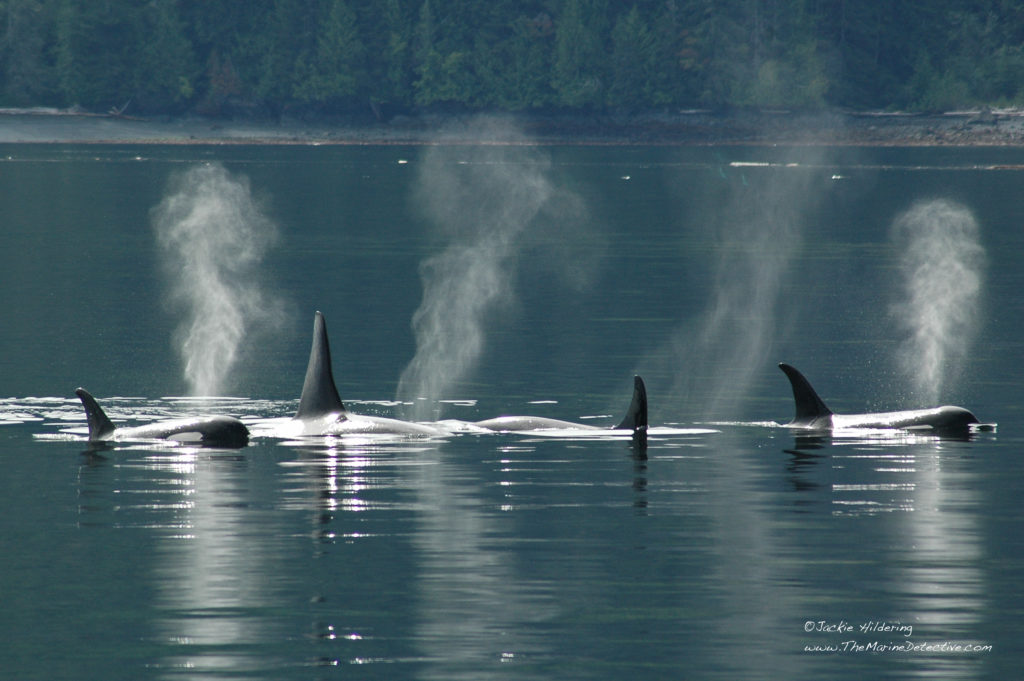time to put our menu where our mouth is
“Salmon are themselves a proud race. They are happy to come ashore each year and give their rich flesh to feed the people, but they must be treated with respect.”
Donna Joe, Salmon Boy
Wild Pacific Salmon are the backbone of our ecosystems, coastal cultures and much of our economy here in British Columbia. At Nimmo Bay, located in the Great Bear Rainforest, we are concerned about how fishing and aquaculture practices are pushing some ocean ecosystems to the brink of collapse. Wild salmon populations have plummeted due to loss of habitat or obstruction of spawning corridors (logging and dams are the most obvious examples of this), fish farms, climate change, and a reduction of diversity and resilience due to overfishing and hatcheries. These outstanding threats to Salmon numbers on the West coast are generally referred to as The Four Hs: Hydro, Harvest, Hatcheries and Habitat.
Hydro, Harvest, Hatcheries and Habitat
If you love seafood, this shouldn’t be the first time you’ve heard that wild fish are in trouble. Many think that it would make sense to eat farmed fish instead, however, in reality, choosing farmed salmon over wild does nothing to affect how much wild salmon is commercially fished, and can also lend a hand in harming our beloved Wild Salmon stocks.
In 2020, data showed a dramatic and widespread reduction in the number of spawning Wild Salmon.
The decline in BC’s salmon abundance over the past 40 years has been a slow moving environmental disaster (very similar to the collapse of the east coast cod fishery almost thirty years ago) and without action, BC’s Salmon population could be next. Unfortunately, the causes are similar: governments making short-term political choices to benefit industries in the face of contradicting scientific advice. We are now at the tail end of a long decline of Salmon species and we as humans should not be okay with allowing them to go extinct on our watch.
Do you like the hard numbers and science? Check out the data from Salmon Coast in their Status of Pacific Salmon Report or listen to the Podcast.
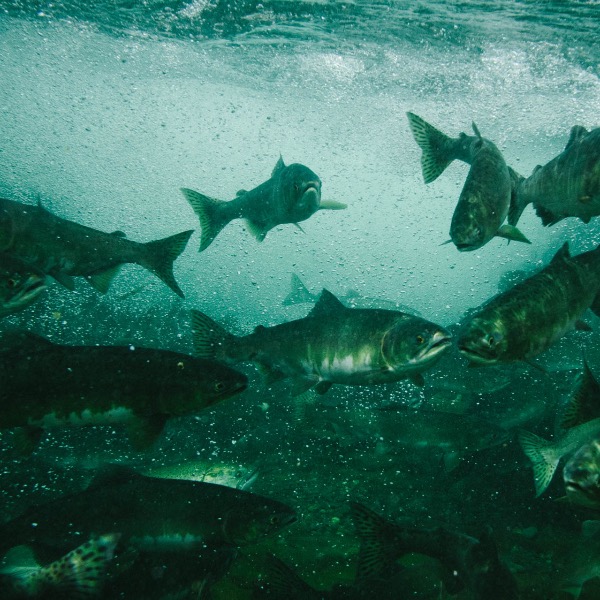
Today, approximately 70 percent of the Salmon that the general public consumes comes from farms.
To put it simply for people who are less familiar with the subject, open-water farming of salmon is a serious threat to the balance of life on the coast and to wild salmon in particular. They spread disease, waste, chemicals, and parasites from the farms and pollute the surrounding water and seabed. Especially harmful are the sea lice who attach to wild juvenile salmon on their migration out to sea, killing many. Mankind’s next “solution”? Grow salmon in closed containment on land. Again, a far from natural approach but a much better alternative to ocean-farmed salmon. A barrier between farmed salmon and the ocean helps to protect the ecosystem and Wild Salmon from the problems caused by industrial salmon farming, however, closed-containment aquaculture systems have no effect on how much Wild Salmon is caught each year. To sum it up, if Salmon farming doesn’t help reduce the pressure from overfishing on wild fish and fishermen can’t catch more wild fish to meet demand because that would lead to overfishing, and low harvests in the future. The answer seems pretty simple to us: eat less Salmon (and stay far away from open-water farmed Salmon).
Hatcheries also have a negative effect on Wild Salmon. Though first implemented to help boost Salmon numbers, the use of traditional hatchery programs has actually contributed to the overall decline of wild populations. Dumping genetically bred fish into wild rivers to try and boost Salmon numbers does not increase the number of wild fish. Instead, it changes their genetic makeup as the hatchery Salmon breed with the Wild Salmon, further degrading the genetics of the fish until you no longer have a wild species —essentially devolving the species. This alone could very easily lead to completely wiping out all Wild Salmon. Hatchery species also challenge the Wild Salmon numbers that are trying to recover as they are more vulnerable though predation, physical displacement and competition for resources.
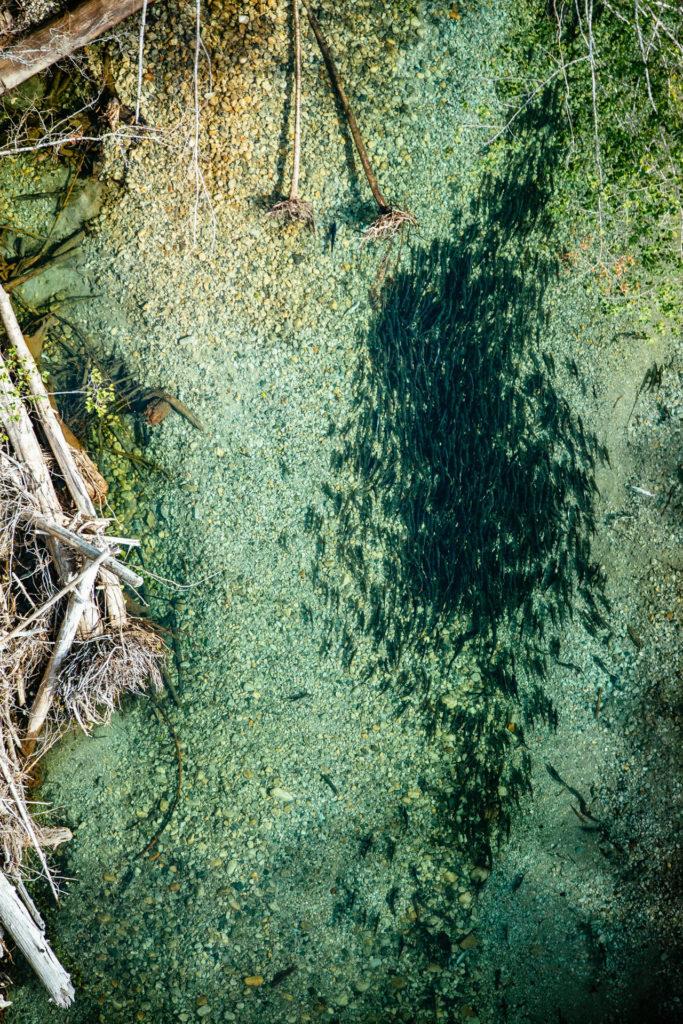
So, Why do hatcheries still exist if all this is true?
Hatcheries and politics
Unfortunately, in most cases, hatcheries are simply a political power pawn and mostly have to do with money.—it’s a huge industry based on licensing, and is a subsidy to commercial and recreational fishermen, paid for by taxpayers. This results in billions of dollars blatantly poured into a system that obviously is more harmful than helpful. We believe that this money should be directed to conservation instead of the hatcheries and farms that have proven to be lucrative for the few but damaging to the ecosystems which support the many.
Technology and human interference have their limits
We need to be aware of these limits and allow nature to regenerate and heal before it is too late. It is a matter of trying to work with nature rather than trying to manipulate or control it. We need to recognize that these methods are not the way forward and it is time to pull back and turn to alternative approaches like protecting and restoring wild things that should have been kept wild.
Humans are certainly not the only species who rely on and benefit from the successive recurrences of the life cycles of Wild Salmon. Spawning runs also contribute to nourishing riverine and forest ecosystems that rely on the complex nutrients from the lifecycle of these fish. The carcasses of spawned salmon are taken by other animals such as bears and eagles above the river bank, where the rich molecules of the Salmon are cycled through to the beautiful forest ecosystem.
Traditional use and cultural value
Salmon is an also essential resource to many First Nations people and communities in B.C. today and historically. They are deeply embedded in the culture, identity, existence, and livelihood of the community. While Salmon is still an important part of their traditional and social practices, it used to be a major form of trade and communication between villages. Since time immemorial, Coastal First Nations people established harvesting agreements and sophisticated techniques to share, monitor, and fish local salmon populations. Indigenous fishing techniques were not only highly productive, but the timing and level of harvest was carefully regulated through systems of what we today would call “resource management.” The value and respect that the people have for the Wild Salmon is reflected in the representation of these fish in traditional stories, songs, dances, and art throughout British Columbia. We should look to the Coastal First Nations people’s respect for the life and symbolism of abundance of Salmon as an example.
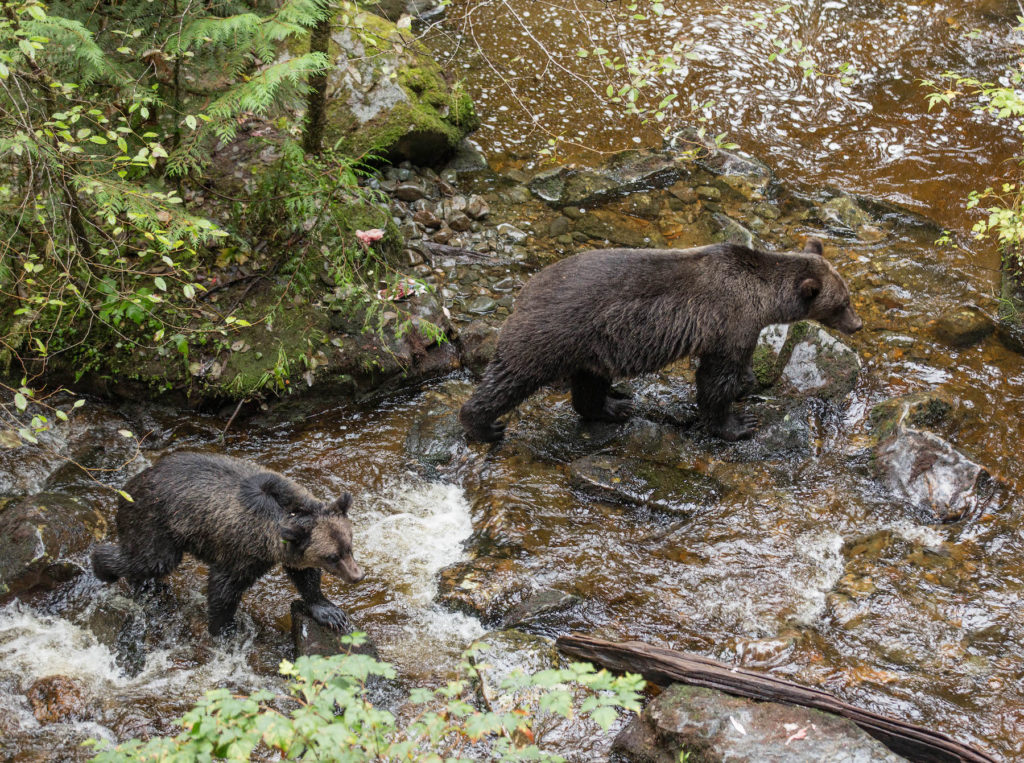
Get Involved
A few things we can easily do as individuals to help save these Salmon is support conservation organizations (monetarily, volunteering, or social support), adopt more sustainable fishing practices that kill fewer fish from endangered populations, raise awareness amongst our family, friends and social networks about farmed Salmon and the threat to Wild Salmon, simply say “no” more often to purchasing or eating Salmon (less demand means less fishing, giving hope to Wild Salmon numbers rebounding), and, of course, by addressing today’s climate crisis.
Anyone who is remotely concerned with the state of the environment and the future of our planet should be actively participating in protecting and preserving our ecosystems.
One of the few organizations researching and collecting data is Salmon Coast, located in Echo Bay in the Broughton Archipelago. Salmon Coast is a charitable, non-profit organization and hub for coastal BC research that supports research, public education, community outreach and ecosystem awareness to achieve lasting conservation measures for the lands and waters of the Broughton Archipelago and surrounding areas. Annual data is collected by stream walkers (or by helicopter surveys in larger rivers) in the late summer and autumn who count the Salmon going upstream to spawn to give an estimate number for each species. Research done in the southern Great Bear Rainforest, where Nimmo Bay is located, shows that Wild Salmon populations are generally doing poorly in an assessment of abundance but in terms of resilience (likelihood to rebound if given the opportunity) they are doing fair. We are concerned by numbers but there is great possibility of wild salmon stocks rebounding if we act now and ease the stresses that affect our Salmon populations.
Since 2015, Nimmo Bay has added a new step to its catch-and-release fly-fishing program to assist researchers in gathering more genetic data. To collect DNA, a small hand hole punch is used to clip tissue from the adipose fin of Salmon caught by guests. The information taken with each samples includes the date, time, location, species, sex, water temperature and is then sent to the Molecular Genetics Laboratory at the Pacific Biological Station, where they are analyzed by researchers to contribute to the bigger conversation on how to protect rivers and make decisions about how to best support Wild Salmon in their natural environment. The Catch-Clip-Release program was founded in partnership with Sea to Cedar and Salmon Coast.
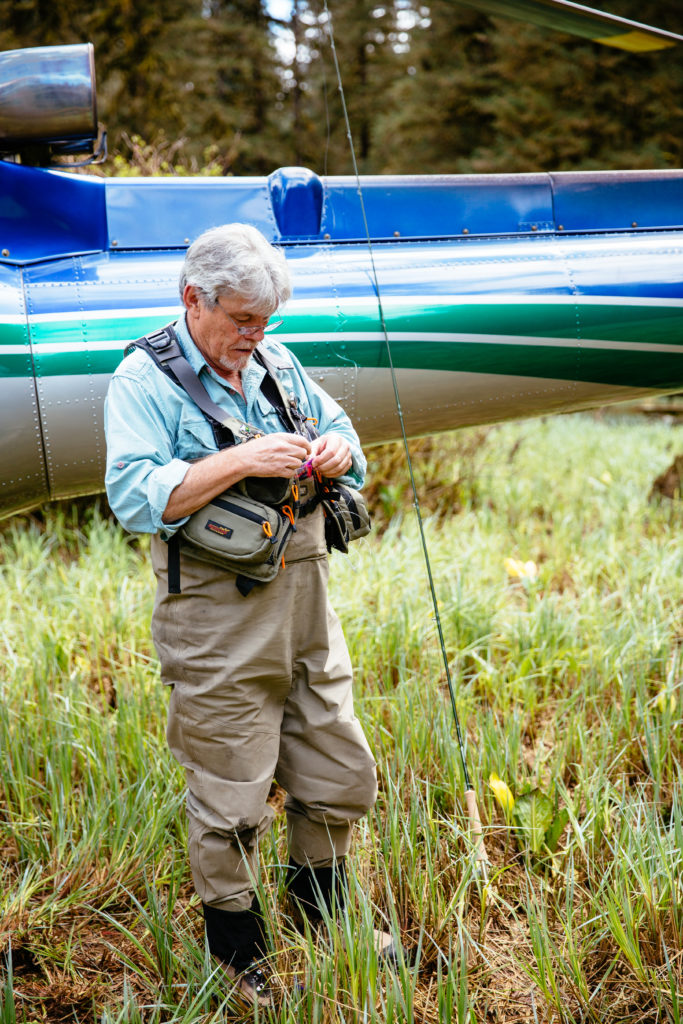
As of the 2020 Season at Nimmo Bay, we have decided to no longer serve Salmon for the time being. If there is an instance that a guest catches and insists on keeping that Salmon, we bring it back to the kitchen and prepare it in an intentional way that all the guests can enjoy with a transfer of knowledge to raise awareness of the current state of Wild Salmon populations. We do not order it from suppliers to offer to our guests as we are yet to find a preferable product from a land-locked farm. And for the above stated reasons, we hope to be part of the movement in restoring Wild Salmon populations. Until we see Wild Salmon numbers rise or we find a way to ethically procure a farmed product, we are committed to raising awareness by example of not using this species, in hopes of humanity doing their part in supporting the return of wild stocks to healthy levels. Until then, Salmon is off the menu.
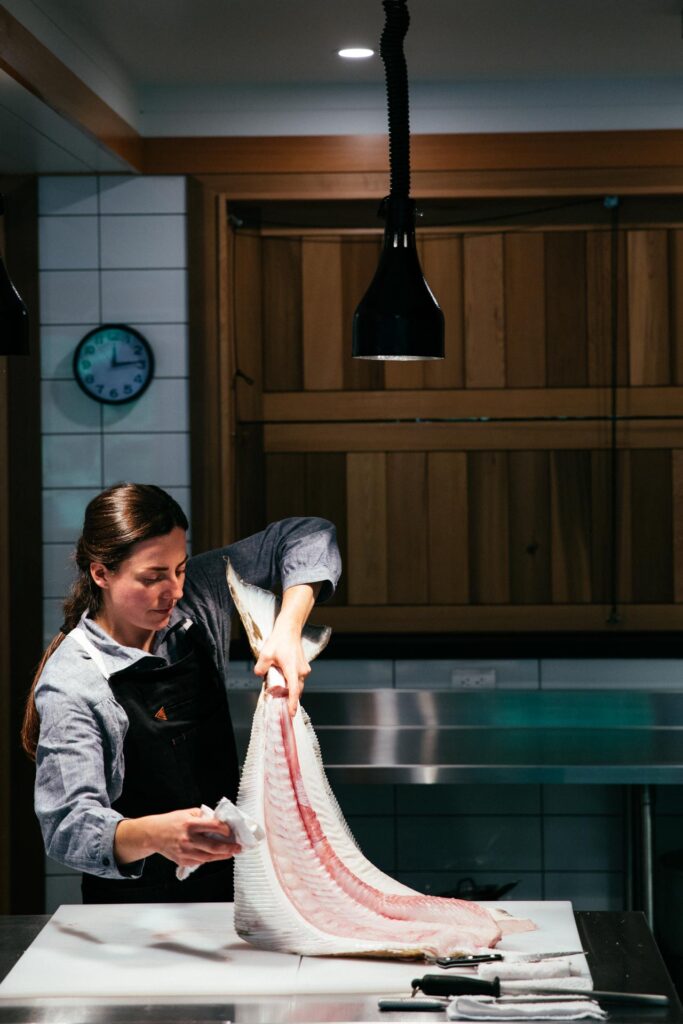
We feel that as part of the community in the Broughton Archipelago, it is our responsibility to educate the public on this topic and hopefully influence others to participate in raising awareness and taking action to support and restore Wild Salmon populations.
Words: Linnea Letourneau
Photos: Jeremy Koreski *Bears by Adrien Mullin
